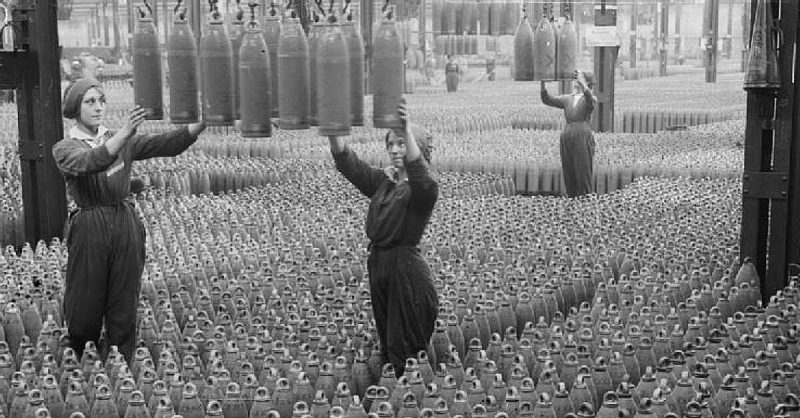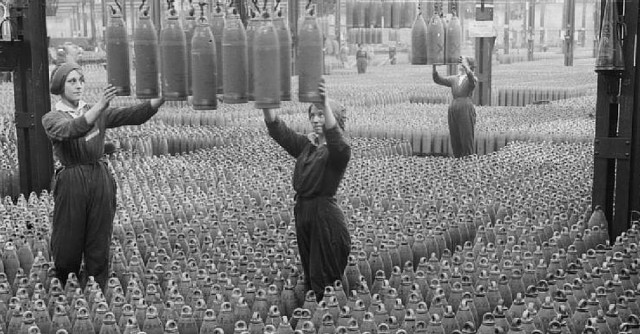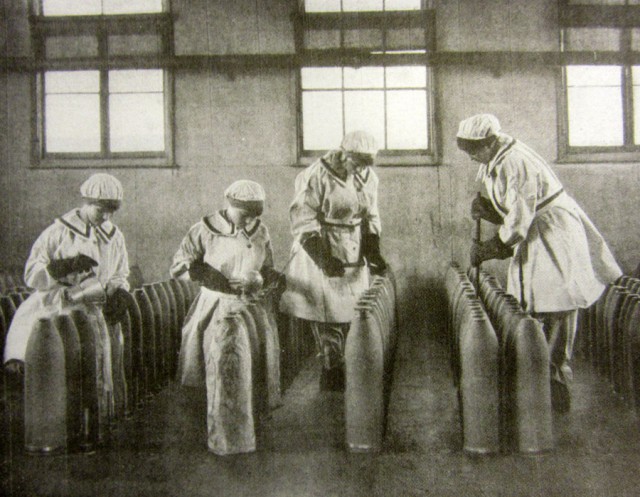It is sadly something you might see in reimagined Wizard of Oz – girls in ruffled hats, full skirts, puffy sleeves, and Peter Pan collars topped by golden faces and bright yellow, orange, or red hair. They were called The Canary Girls. Not only did they have to abide these odd looks, but the children they gave birth to during this time often did as well.
This was a disturbing side effect to working in munitions plants in WWI Britain. The TNT caused workers’ skin to turn yellow. Because the boys were off at war, most of the plant workers were women, and so those suffering from this peculiar aberration became known as The Canary Girls.
Munitionette Caroline Rennles later recalled “So it was all bright ginger, all our front hair, you know. And all our faces were bright yellow – they used to call us canaries . . . some of them used to look at us as though we was insects, know what I mean? And others used to mutter, ‘Oh well they’re doing their bit.’ As I say, some was quite nice and others, you know, used to treat us as though we was scum of the earth. ’Course we, all our clothes like, we couldn’t wear like good clothes because the powder used to seep into your clothes, know what I mean?”
The effects were more than cosmetic. Many women complained of nausea and skin rashes or hives. Some had coughs or chest infections from TNT poisoning. According to a TNT factory worker quoted in Katie Adie’s 2013 book, Fighting on the Homefront, “You expected to feel ‘poorly’; our skin was perfectly yellow, right down through the body, legs and toenails even.”
Another Canary Girl, Ethel Dean, related in an interview archived by the Imperial War Museum that “Everything that that powder touches goes yellow. All the girls’ faces were yellow, all round their mouths. They had their own canteen, in which everything was yellow that they touched… Everything they touched went yellow – chairs, tables, everything.” The prolonged exposure to the yellow TNT even caused some to give birth to yellow babies.
Keep in mind that these factories were so dangerous that women were not allowed to bring in hair pins or matches and that every minute movement was done with care to avoid any explosions. They were under quite a lot of physical and mental stress without adding itching and burning that they likely couldn’t scratch on top of it. For all of this strife, they were paid less than half of what the men before them had made. They worked long shifts, often as many as 12 hours a day in nearly unbreathable air.
Lilian Miles remembers her sister Grace, “She died in terrible pain and they said that they reckoned that black powder it burnt the back of her throat away. And the continual breathing of this black powder it sort of burnt the back of her throat away.”
While TNT poisoning is quite serious, whether or not the effects of yellowed skin and hair among the children were otherwise long ranging is unknown. One Canary Baby, Gladys Sangster, turned 97 in 2014 after living her entire life near the site of the munitions factory where her mother worked. She said that she had suffered no ill effects after the color faded when she was still a baby.
Sources:
- https://sheroesofhistory.wordpress.com/2014/11/13/remembering-the-munitionettes-of-the-first-world-war/
- http://www.mylearning.org/female-munitions-workers-in-ww1/p-4697/
- http://www.dailymail.co.uk/news/article-2561630/The-war-children-born-YELLOW-How-women-working-explosives-factories-sparked-clutch-Canary-Babies-WW1.html
- https://en.wikipedia.org/wiki/Canary_girls
- http://www.iwm.org.uk/history/podcasts/voices-of-the-first-world-war/podcast-16-munitions
- https://books.google.com/books?id=_e05AgAAQBAJ&printsec=frontcover&dq=fighting+on+the+homefront&hl=en&sa=X&ved=0CBwQ6AEwAGoVChMIn-3JscPpyAIVBlcmCh3O0QCO#v=onepage&q=fighting%20on%20the%20homefront&f=false
- http://www.iwm.org.uk/history/9-women-reveal-the-dangers-of-working-in-a-first-world-war-munitions-factory


